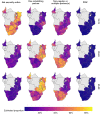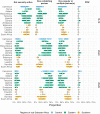Spatio-temporal estimates of HIV risk group proportions for adolescent girls and young women across 13 priority countries in sub-Saharan Africa
- PMID: 37075002
- PMCID: PMC10115274
- DOI: 10.1371/journal.pgph.0001731
Spatio-temporal estimates of HIV risk group proportions for adolescent girls and young women across 13 priority countries in sub-Saharan Africa
Abstract
The Global AIDS Strategy 2021-2026 identifies adolescent girls and young women (AGYW) as a priority population for HIV prevention, and recommends differentiating intervention portfolios geographically based on local HIV incidence and individual risk behaviours. We estimated prevalence of HIV risk behaviours and associated HIV incidence at health district level among AGYW living in 13 countries in sub-Saharan Africa. We analysed 46 geospatially-referenced national household surveys conducted between 1999-2018 across 13 high HIV burden countries in sub-Saharan Africa. Female survey respondents aged 15-29 years were classified into four risk groups (not sexually active, cohabiting, non-regular or multiple partner[s] and female sex workers [FSW]) based on reported sexual behaviour. We used a Bayesian spatio-temporal multinomial regression model to estimate the proportion of AGYW in each risk group stratified by district, year, and five-year age group. Using subnational estimates of HIV prevalence and incidence produced by countries with support from UNAIDS, we estimated new HIV infections in each risk group by district and age group. We then assessed the efficiency of prioritising interventions according to risk group. Data consisted of 274,970 female survey respondents aged 15-29. Among women aged 20-29, cohabiting (63.1%) was more common in eastern Africa than non-regular or multiple partner(s) (21.3%), while in southern countries non-regular or multiple partner(s) (58.9%) were more common than cohabiting (23.4%). Risk group proportions varied substantially across age groups (65.9% of total variation explained), countries (20.9%), and between districts within each country (11.3%), but changed little over time (0.9%). Prioritisation based on behavioural risk, in combination with location- and age-based prioritisation, reduced the proportion of population required to be reached in order to find half of all expected new infections from 19.4% to 10.6%. FSW were 1.3% of the population but 10.6% of all expected new infections. Our risk group estimates provide data for HIV programmes to set targets and implement differentiated prevention strategies outlined in the Global AIDS Strategy. Successfully implementing this approach would result in more efficiently reaching substantially more of those at risk for infections.
Copyright: © 2023 Howes et al. This is an open access article distributed under the terms of the Creative Commons Attribution License, which permits unrestricted use, distribution, and reproduction in any medium, provided the original author and source are credited.
Conflict of interest statement
I have read the journal’s policy and the authors of this manuscript have the following competing interests: Kathryn A. Risher was supported through a consultancy via UNAIDS to conduct an early version of this work; Lycias Zembe, Ian Wanyeki, Mary Mahy, and Clemens Benedikt are employees of UNAIDS; Jeffrey W. Eaton is a member of the editorial board for PLOS Global Public Health; other authors have declared that no competing interests exist.
Figures




References
-
- UNAIDS. 2021 UNAIDS Global AIDS Update—Confronting Inequalities—Lessons for pandemic responses from 40 Years of AIDS. Geneva, Switzerland; 2021.
-
- UNAIDS. HIV prevention among adolescent girls and young women. Geneva, Switzerland. 2016.
-
- The Global Fund. The Global Fund Measurement Framework for Adolescent Girls and Young Women Programs. 2018. Available: https://www.theglobalfund.org/media/8076/me_adolescentsgirlsandyoungwome...
-
- UNAIDS. Global AIDS Strategy 2021-2026—End Inequalities; End AIDS. UNAIDS. 2021.
Grants and funding
LinkOut - more resources
Full Text Sources
